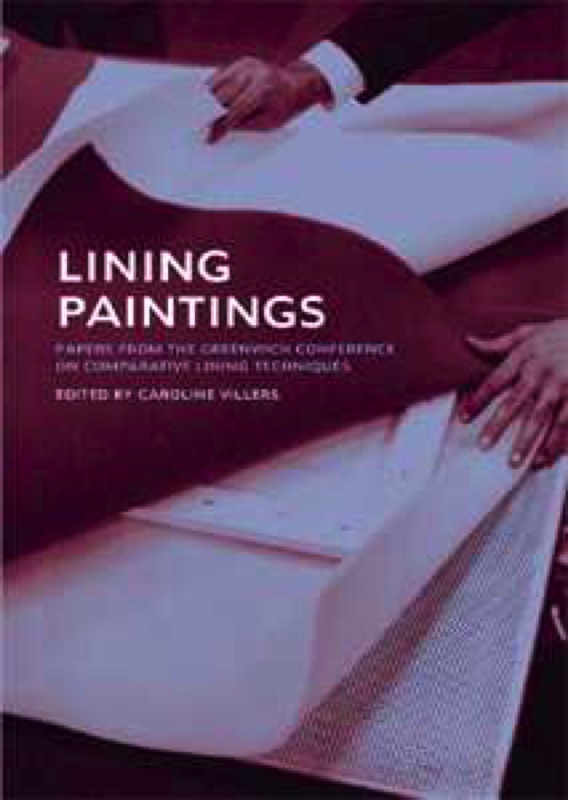The Conference on Comparative Lining Techniques held at the National Maritime Museum, Greenwich is legendary. It was the first major conference solely concerned with the structural conservation of paintings and, by bringing together a distinguished international group of practitioners to discuss lining paintings, it changed the nature and status of the debate. The Conference responded to a period of accelerating change, especially the introduction of new materials and technologies, and the papers presented compare established practice with cutting edge research and development, empirical craftsmanship with scientific methodology with the goal of refining the practice of lining and minimising the risks of change to the painting.
The extraordinary atmosphere, the films, demonstrations, the Lining Exhibition Gallery all encouraged radical review. The papers and conference materials record practice and principles at a critical moment in the history of conservation and constitute one of the most important foundational texts about conservation in the late 20th century.
This volume contains the papers as originally presented, some of which have been brought up to date with the addition of commentaries. A glossary of terms (previously issued as a handbook) and a new select bibliography are included.
Foreword
Westby Percival-Prescott
Introduction
Caroline Villers
The lining cycle: causes of physical deterioration in oil paintings on canvas: lining from the 17th century to the present day
Westby Percival-Prescott
Effects of consolidation measures on fibrous materials
Gustav A. Berger and Harold I. Zeliger
Wax impregnation of cellulose: an irreversible process
Gustav A. Berger and Harold I. Zeliger
The removal of old linings from oil paintings by the use of the vacuum hot table
John R. Essex
A method for lining canvas paintings with glue composition
Peter Newman
Comparisons of dimensional stability between woven glass fibre fabric and conventional linen canvas as lining supports for paintings
Pierre Boissonnas
Consolidation and lining adhesives compared
Robert E. Fieux
Notes on a recent relining problem
Joan Seddon
Prestretched low-pressure lining methods
Ronald Chittenden, Gillian Lewis and Westby Percival-Prescott
Lining of a torn painting with BEVA 371
Gustav A. Berger
Microbial environment: SEM examination of the microbial environment in works of art
Bjorn Hallstrom and Bo Goransson
Hand lining with wax-resin using an iron
Georges Messens
Unusual examples of lining on wax-resin
Bohdan L. Marconi
Lining in a vacuum envelope with a traversing infrared heat source
G.A. Hedley, S. Hackney and A.J. Cummings
Surface texture changes in vacuum lining: experiments with raw canvas
Alan Cummings and Gerry Hedley
Characterisation of lining canvases
Enzo Tassinari
Relining of easel oil painting with sturgeon glue
L. Yashkina
Adhesive method of consolidating oil paintings with cuppings and hard craquelure
L. Yashkina
Lining and relining methods and rules evolved at the National Gallery Conservation Department
Arthur Lucas
The development of wax-composition lining among the members of the Association of British Picture Restorers
Philip Robinson
Italian lining techniques: lining with pasta adhesive (and other methods) at the Fortezza da Basso, Florence
Umberto Baldini and Sergio Taiti
A low-pressure cold-relining table
V.R. Mehra
Some effects of impregnating adhesives on paint films
Gustav A. Berger
Appendix 1 Relining materials and techniques: summary of replies to a questionnaire
S. Rees Jones, Alan Cummings and Gerry Hedley
Appendix 2 Conference announcement, Technical Committee, list of delegates
Appendix 3 The Lining Exhibition Gallery and photographs of conference delegates
Appendix 4 Glossary (originally Handbook of Terms Used in Lining of Paintings)
Appendix 5 A select bibliography for the structural conservation of canvas paintings
Paul Ackroyd
Reviews
In light of the lengthy hiatus between the event and the publication of these edited papers...one might reasonably wonder if such a publication is useful a generation after the original presentations were made...It might be said that while still useful in a practical sense, this book is more interesting in a historical one, because it is a time capsule that allows us a careful look at an era in our profession when many lining techniques, some traditional and others innovative, were being evaluated for the first time.
Studies in Conservation 50 (2005) 78-79
